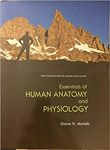
Concept explainers
Introduction:
The respiratory system comprises of lungs, nose, trachea, pharynx, larynx, bronchi, and alveoli. Alveoli are the sac-like structures present in the lungs. These are the actual sites of gaseous exchange in the entire respiratory system. The kind of cells that are present in the alveoli depends on the function they perform.
Answer to Problem 1MC
Correct answer:
The cells present in the alveoli of the lungs are squamous and cuboidal epithelia and macrophages.
Explanation of Solution
Justification/Explanation for the correct answers:
Option (a) is given that squamous epithelia are present in the alveoli. The alveolar wall is made up of a single layer of these cells. The thinness of the sacs allow air to pass in between the adjoining air sacs and at the same time, allow expansion. Hence, option (a) is correct.
Option (b) is given that macrophages are present in the alveoli. Macrophages are the defensive cells, which trap the bacterial particles that manage to pass through the nasal hairs and other air passageways. Hence, option (b) is correct.
Option (d) is given that cuboidal epithelia are present in the alveoli. These cells are present in between the other epithelial cells inside the alveolar sac. They produce a lipid molecule, that lubricates the alveoli. This surfactant reduces the surface tension during each contraction and expansion of the alveolar sac and thus, prevent the alveoli from collapsing. Hence, option (d) is correct.
Explanation for the incorrect answer:
Option (c) is given that columnar epithelia are present in the alveoli. These cells are either ciliated or non-ciliated. These cells are present in regions, where movement of particles is required. The ciliated ones are present in the upper respiratory tract and the non-ciliated ones are mostly secretive and/or protective in nature. The alveoli are free of any kind of particles. As the secretion is carried out by the cuboidal epithelial cells, these cells have no use here. So, it is an incorrect option.
Hence, option (c) is incorrect.
Thus, the alveoli are made up of simple squamous cells that line the alveolar surface, cuboidal epithelia that is present inside the sac, and macrophages that serve as the third line of defense in the respiratory system.
Want to see more full solutions like this?
Chapter 13 Solutions
Essentials of Human Anatomy and Physiology (Custom)
- Amino Acid Coclow TABle 3' Gly Phe Leu (G) (F) (L) 3- Val (V) Arg (R) Ser (S) Ala (A) Lys (K) CAG G Glu Asp (E) (D) Ser (S) CCCAGUCAGUCAGUCAG 0204 C U A G C Asn (N) G 4 A AGU C GU (5) AC C UGA A G5 C CUGACUGACUGACUGAC Thr (T) Met (M) lle £€ (1) U 4 G Tyr Σε (Y) U Cys (C) C A G Trp (W) 3' U C A Leu בוט His Pro (P) ££ (H) Gin (Q) Arg 흐름 (R) (L) Start Stop 8. Transcription and Translation Practice: (Video 10-1 and 10-2) A. Below is the sense strand of a DNA gene. Using the sense strand, create the antisense DNA strand and label the 5' and 3' ends. B. Use the antisense strand that you create in part A as a template to create the mRNA transcript of the gene and label the 5' and 3' ends. C. Translate the mRNA you produced in part B into the polypeptide sequence making sure to follow all the rules of translation. 5'-AGCATGACTAATAGTTGTTGAGCTGTC-3' (sense strand) 4arrow_forwardWhat is the structure and function of Eukaryotic cells, including their organelles? How are Eukaryotic cells different than Prokaryotic cells, in terms of evolution which form of the cell might have came first? How do Eukaryotic cells become malignant (cancerous)?arrow_forwardWhat are the roles of DNA and proteins inside of the cell? What are the building blocks or molecular components of the DNA and proteins? How are proteins produced within the cell? What connection is there between DNA, proteins, and the cell cycle? What is the relationship between DNA, proteins, and Cancer?arrow_forward
- please fill in the empty sports, thank you!arrow_forwardIn one paragraph show how atoms and they're structure are related to the structure of dna and proteins. Talk about what atoms are. what they're made of, why chemical bonding is important to DNA?arrow_forwardWhat are the structure and properties of atoms and chemical bonds (especially how they relate to DNA and proteins).arrow_forward
- The Sentinel Cell: Nature’s Answer to Cancer?arrow_forwardMolecular Biology Question You are working to characterize a novel protein in mice. Analysis shows that high levels of the primary transcript that codes for this protein are found in tissue from the brain, muscle, liver, and pancreas. However, an antibody that recognizes the C-terminal portion of the protein indicates that the protein is present in brain, muscle, and liver, but not in the pancreas. What is the most likely explanation for this result?arrow_forwardMolecular Biology Explain/discuss how “slow stop” and “quick/fast stop” mutants wereused to identify different protein involved in DNA replication in E. coli.arrow_forward
 Concepts of BiologyBiologyISBN:9781938168116Author:Samantha Fowler, Rebecca Roush, James WisePublisher:OpenStax College
Concepts of BiologyBiologyISBN:9781938168116Author:Samantha Fowler, Rebecca Roush, James WisePublisher:OpenStax College Cardiopulmonary Anatomy & PhysiologyBiologyISBN:9781337794909Author:Des Jardins, Terry.Publisher:Cengage Learning,
Cardiopulmonary Anatomy & PhysiologyBiologyISBN:9781337794909Author:Des Jardins, Terry.Publisher:Cengage Learning, Medical Terminology for Health Professions, Spira...Health & NutritionISBN:9781305634350Author:Ann Ehrlich, Carol L. Schroeder, Laura Ehrlich, Katrina A. SchroederPublisher:Cengage Learning
Medical Terminology for Health Professions, Spira...Health & NutritionISBN:9781305634350Author:Ann Ehrlich, Carol L. Schroeder, Laura Ehrlich, Katrina A. SchroederPublisher:Cengage Learning





